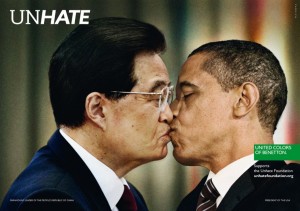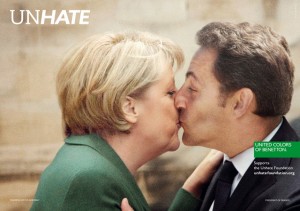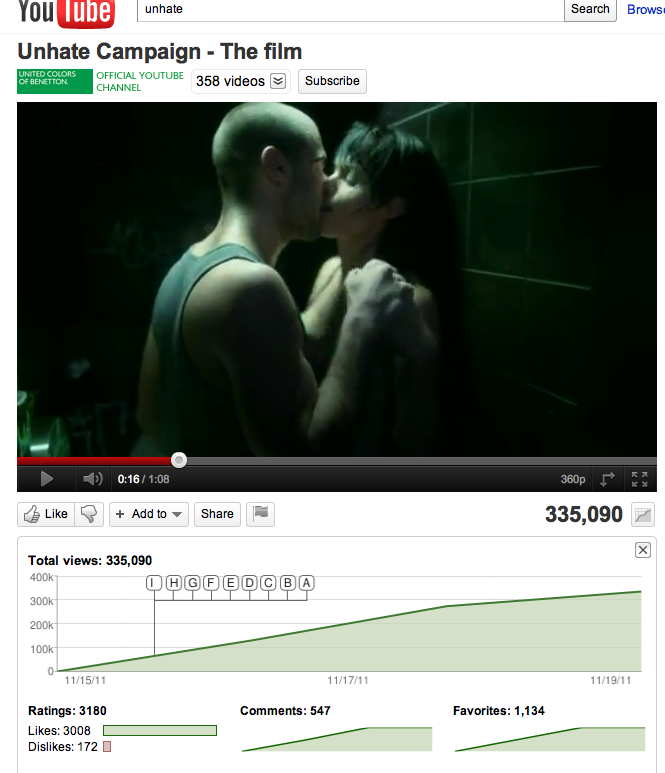The shocking picture of president Obama kisses Chinese Chairman Hujintao appeared on the Internet Nov 15th 2011. It is from Benetton again, who notoriously launched a series of highly controversial ads in the past. It seems that Benetton has come back. This time it wants to make a bigger impact with the new tools available like social media.
This is an exciting marketing event, not only because its controversy, but also more related to the fact that we are able to simultaneously observe how marketers plant the story and how media disseminates the influence of brand messages. It’s like a live show of how Benetton experiments its marketing principles in the digital era!
What this campaign is all of about?
The campaign started on Nov 15th 2011 in the name of “UNhate foundation” by Benetton. The central theme is to build “a culture of tolerance”and to “combat hatred”. The proposition is expressed by “kiss”, the “most universal symbol of love”. It was said to connect to Benetton’s core brand value and to embrace many “UNhate” initiatives, for example, establish “UNhate” day, facilitate acceptance of diversity and help children. The campaign itself consists of a short film, images political/religious leaders on media, billboards with same images in major cities around the world. Of course, the campaign website provides “kisswall” and “Unhate list” where participants can upload their own pics and messages in connection with Facebook and Twitter.
Did it go viral?
It would make an elegant but quiet marketing communication project if the campaign hadn’t featured the following influential figures having kisses: U.S. President Obama, Chinese Chairman Hu Jintao, Venezuela President Hugo Chavez, German Chancellor Angela Merkel, French President Nicolas Sarkozy and many others…
With these eye-catching images, it was expected that the campaign would turn to viral really fast. I started monitoring “UNhate” online impact since I first saw it early morning today. Up until now (16 hours so far), Number of Facebook “Likes” of the campaign increased from 10K to 15K; the Benetton site ranking went up considerably; campaign film also attracted hits more than 330,000 within 3 days on youtube.
It’s too early yet to tell if the campaign has realized the expected impact in terms of audience reach (here not mention the quality of publicities yet), but I will keep you updated.
What might be the underlying reasons for Benetton doing this campaign?
Claimed by Alessandro Benetton, the leader of Benetton company, that the purpose of this campaign was to “reaffirm the value of the brand” and connect the past to the future. To some extent, the proposition was relevant with what Benetton’s previous brand image and promise. But it attracted lots of speculation because Benetton did not perform as good as the competitors as Zara or H&M in financial terms. So there is a high probability the campaign was designed to catch short-term market attention and regain the lost-ground.
How the message was communicated?
First of all, Benetton used the integrated marketing communication concept to ensure the exposure to target audience. Secondly, it tried online and offline integration to enhance the communication engagement. Thirdly, the campaign leveraged various social media tools and user generated content to enrich the interactivity.
Social media is like a natural fit for Benetton’s style of message: controversy leading to mixed responses. Now Benetton finally comes to play around the social media with its beautifully crafted campaign content. One thing is for sure: social media will accelerate the diffusion of the message and deepen the latitude of reach. But whether social media impacts the campaign more in a positive way or the other direction is still not clear.
Meanwhile, a few issues have already emerged: tremendous opposition from the public as a result Pope’s picture was forced to delete. Even White House protested the inappropriateness of the images. Benetton is also likely to receive potential complaints from North Korea or China where the political leaders are highly respected.
The primary consideration for Benetton now is probably, the more controversial the campaign becomes, the better attention brand attracts. Controversy might be one of the characters of the brand. But how likely is the short-term attention will last and how this will help to recapture consumer attention? and how this action will favourably drive financial performance?
Probably Benetton needs to fine-tune its product and design first. At the end of day, “go viral” doesn’t mean anything if your product is not competitive in physical terms. Or it still doesn’t make sense if the propaganda is not relevant to what you sell. A common pitfall in this digital world now is that we sometimes care too much about the “silver bullets” instead of some unchanged marketing rules.








